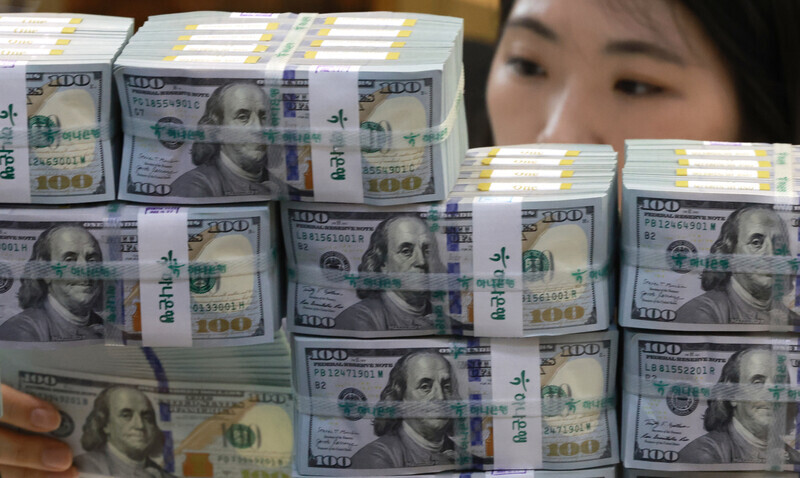hankyoreh
Links to other country sites 다른 나라 사이트 링크
Why the won’s value is falling despite a weakening dollar

The strength of the US dollar is in decline, but the South Korean won has not been able to assert its strength and is going down with it. Experts attribute this to South Korea’s weakening economic fundamentals, such as its trade deficit.
With the government expecting the export environment to improve in the second half of 2023, attention is focused on whether the won will be able to bounce back as well.
On the Seoul foreign exchange market on Thursday, the won-dollar exchange rate closed at 1,322.8 won, down 2.9 won from the previous trading day. It rose to 1,332.3 won per dollar at one point during the day, the highest in about five months since Nov. 29, 2022 (1,342 won). By the close, it had fallen for the first time in four trading days.
The dollar, once dubbed the “king,” has been weakening this year amid uncertainty over the US Federal Reserve’s monetary policy. The dollar index, which tracks the value of the US dollar against a basket of six major currencies (including the euro, yen, and pound sterling), stood at 101.94 on Wednesday, down 2.47% from the start of 2023 (Jan. 3), a directed indication of how much the value of the dollar has fallen.
As a general rule, when the value of the dollar falls, the Korean won to US dollar exchange rate is likely to fall as well. This is because the weaker dollar makes the Korean won relatively more valuable. However, during the same period, the won-dollar exchange rate actually increased by 4.30% (meaning a depreciation of the won), showing the combined weaknesses of both the dollar and the won.
Since mid-March 2023, the dollar index and the won-dollar exchange rate have been moving in opposite directions. In particular, the Korean won seems to have depreciated more than any other currency in 2023. Compared to the beginning of 2023 (Jan. 2), the value of the yen was down by 2.43% as of Wednesday, while the value of the euro was up by 2.63%.
According to a report released Wednesday by the Bank of Korea comparing exchange rates internationally, the rate of depreciation of the won against the dollar in February was 7.4%, more than double the average of 34 countries in the sample (3.0%).
The deterioration of the economic fundamentals of South Korea has been cited as the main reason for the currency’s depreciation. The cumulative trade deficit from the beginning of 2023 through March 20 was US$24.13 billion, more than three times the amount during the same period last year.
So far this year, Korea’s trade deficit is already more than half of last year’s annual deficit (US$47.8 billion), which was the largest on record. Demand for dollars has also increased this month as foreign investors in Korean companies have been collecting dividends.
In other words, Korea’s dollars are being drained through overseas transactions. In addition, the 1.5-percentage-point gap between the Korean and US policy rates (at the top end of the range) is also contributing to the weakening of the won.
“In addition to the uncertainty of US monetary tightening, the recent anomalous trend in the won-dollar exchange rate is also attributed to domestic factors such as the persistent trade deficit,” Korea’s central bank said in its report. “Thailand, South Africa and Argentina, which have recently experienced deteriorating trade balances, also experienced relatively large currency depreciations in February.”
For the won to recover in the future, it is essential to improve South Korea’s economic fundamentals, including export conditions. For this reason, the government is hoping that the benefits of China’s still-slow economic recovery will become visible in the second half of the year and the won will rebound.
“The relative weakness of the won since March is the result of deteriorating dollar supply and demand amid concerns about fundamentals,” Shinhan Securities said in a report. “The won-dollar exchange rate is likely to decline in the second half of the year, and the improvement in the trade balance, which coincides with the full-scale recovery of the Chinese economy in the third quarter, will boost the strength of the won.”
By Cho Hae-yeong, staff reporter
Please direct questions or comments to [english@hani.co.kr]

Editorial・opinion
![[Column] Is Korean democracy really regressing? [Column] Is Korean democracy really regressing?](https://flexible.img.hani.co.kr/flexible/normal/500/300/imgdb/original/2024/0705/2917201664129137.jpg) [Column] Is Korean democracy really regressing?
[Column] Is Korean democracy really regressing?![[Column] How tragedy pervades weak links in Korean labor [Column] How tragedy pervades weak links in Korean labor](https://flexible.img.hani.co.kr/flexible/normal/500/300/imgdb/original/2024/0703/8717199957128458.jpg) [Column] How tragedy pervades weak links in Korean labor
[Column] How tragedy pervades weak links in Korean labor- [Column] How opposing war became a far-right policy
- [Editorial] Korea needs to adjust diplomatic course in preparation for a Trump comeback
- [Editorial] Silence won’t save Yoon
- [Column] The miscalculations that started the Korean War mustn’t be repeated
- [Correspondent’s column] China-Europe relations tested once more by EV war
- [Correspondent’s column] Who really created the new ‘axis of evil’?
- [Editorial] Exploiting foreign domestic workers won’t solve Korea’s birth rate problem
- [Column] Kim and Putin’s new world order
Most viewed articles
- 1[Column] Is Korean democracy really regressing?
- 2Over 200,000 Koreans sign petition calling for deportation of Yemeni refugees in Jeju
- 3What will a super-weak yen mean for the Korean economy?
- 4Former bodyguard’s dark tale of marriage to Samsung royalty
- 5Health care experts call on government to address problems with end of life legislation
- 6Real-life heroes of “A Taxi Driver” pass away without having reunited
- 7Koreans are getting taller, but half of Korean men are now considered obese
- 8BBC documentary’s new revelations about Burning Sun scandal reignite rage, grief in Korea
- 9Shoddy records help Korean hospitals conceal abuse of mentally ill
- 1010 days of torture: Korean mental patient’s restraints only removed after death